Cabinet design marries form and function, blending ergonomics, aesthetics, and space utilization to create the heart of any kitchen. At Upmaxnow, we understand that well-designed cabinetry transforms your kitchen space’s look and efficiency. From innovative storage solutions to cutting-edge materials, modern kitchen cabinet design pushes boundaries while prioritizing user comfort and style.
This article will explore the key principles that shape outstanding cabinet designs and how they can elevate your kitchen experience.
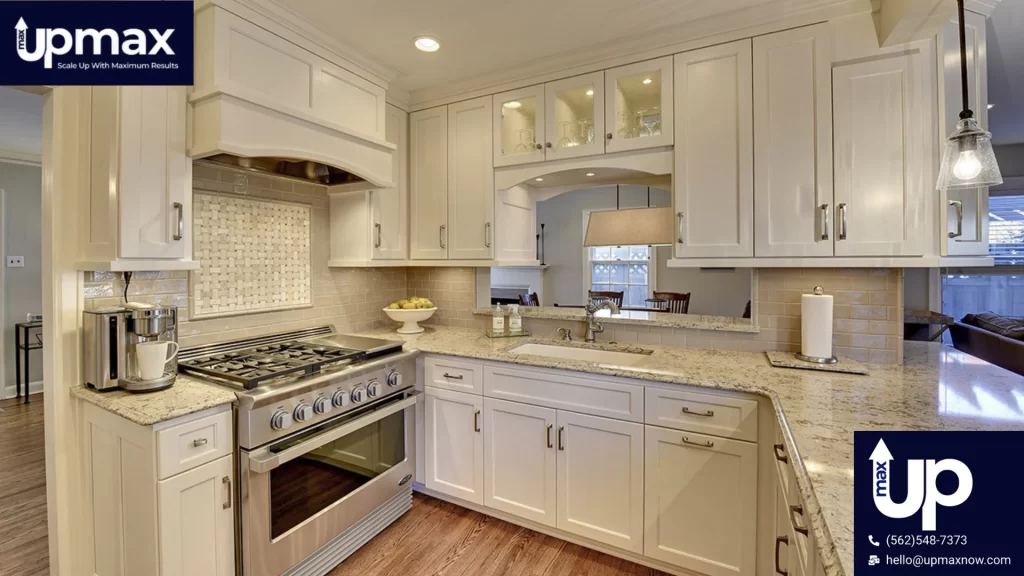
Key Takeaways for Cabinet Designs: Key Principles in Ergonomics, Aesthetics, Functionality, and Space Utilization
- Ergonomic Design Enhances Accessibility: Ergonomically designed cabinets ensure that users of varying abilities find them accessible and comfortable. Proper placement and design reduce strain and increase efficiency.
- Aesthetics and Functionality: Modern cabinet designs blend aesthetics with functionality, serving as storage solutions and statement pieces that enhance the room’s overall appearance.
- Space Utilization: Innovative storage solutions, like pull-out systems and vertical optimization, help maximize storage space, making even small kitchens efficient and stylish.
- Sustainable Materials: Using sustainable and eco-friendly materials in cabinet designs reduces environmental impact and adds unique textures and styles to the space.
- Lighting Integration: Integrating lighting within cabinets improves visibility and ambiance. Techniques like LED strips and sensor-activated lights enhance both functionality and design.
- Universal Design: Cabinets designed with universal principles accommodate all body types and mobility levels, ensuring inclusivity without compromising style or efficiency.
- Smart Technology Integration: Modern cabinet designs incorporate smart technology, including app-controlled storage systems and touchless operations that increase convenience and hygiene.
- Personal Style and Efficiency: Homeowners can infuse personal style through customizable hardware and finishes while maintaining the functional aspects needed for daily use.
- Durability and Longevity: Long-lasting designs and durable materials reduce the need for frequent replacements, contributing to environmental sustainability and long-term cost savings.
- Future Trends: Emerging technologies such as AI-integrated cabinets and augmented reality interfaces will further enhance functionality, making cabinets more intuitive and user-friendly in future homes.
Understanding Ergonomics in Cabinet Design
Ergonomics is crucial in cabinet design, influencing everything from countertop height to drawer placement. This science of human-centered design ensures that kitchen cabinets, bathrooms, and pantries look good and function optimally for users of all sizes and abilities. By considering factors such as reach distances, body mechanics, and visual angles, designers can create wood cabinets that enhance comfort, reduce strain, and improve overall efficiency in daily tasks. The following sections delve into the critical aspects of ergonomic cabinet design, exploring how measurements, height, depth, and placement impact usability across diverse body types.
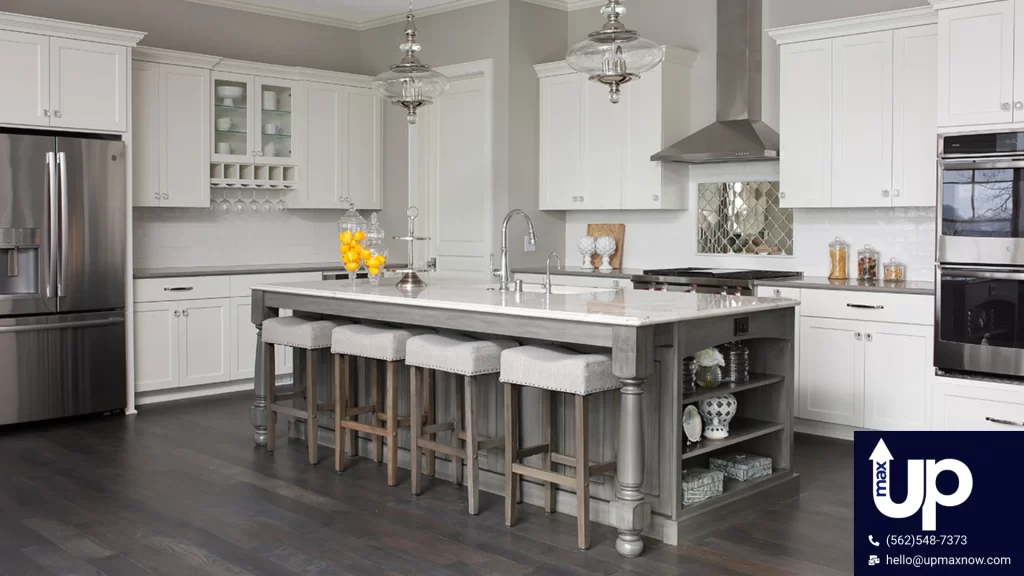
The Basics of Ergonomic Measurements
Ergonomic measurements form the foundation of effective cabinet design, ensuring optimal functionality and comfort in any room. These measurements consider the average human body dimensions and movement patterns, incorporating reach distances, visual angles, and comfortable working heights. During a renovation project, designers use these principles to create cabinets that seamlessly blend with the interior design while maximizing usability.
The application of ergonomic measurements extends beyond mere functionality, influencing the overall aesthetic appeal of the space. By carefully considering cabinet height, depth, and placement, designers can create a harmonious balance between form and function. This approach integrates various materials, including wood and glass, while maintaining a cohesive color scheme that complements the room‘s ambiance.
Key aspects of ergonomic measurements in cabinet design include:
- Optimal counter height for different tasks
- Comfortable reach distances for upper cabinets
- Proper spacing between cabinets and appliances
- Ergonomic drawer depths and pull-out shelving
- Adequate toe kick height and depth
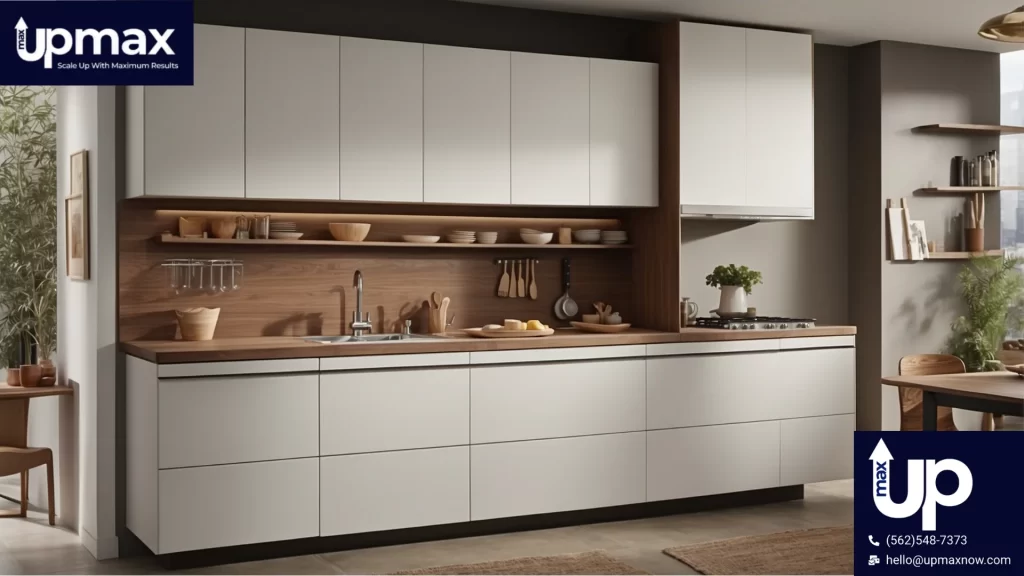
How Height and Depth Affect Usage
The height and depth of cabinets significantly impact their usability and overall functionality within a space. Proper cabinet dimensions ensure comfortable access to stored items, reduce strain on the body, and promote efficient use of available space. This principle applies to kitchen cabinets and other furniture pieces throughout the home, aligning with modern minimalist trends emphasizing clean lines and uncluttered spaces.
Designers must consider the interplay between cabinet dimensions and elements such as wall placement, paint colors, and lighting to create a cohesive and ergonomic environment. By carefully balancing these factors, they can achieve a harmonious blend of form and function that enhances the user experience while complementing the room‘s aesthetic appeal:
| Cabinet Type | Optimal Height Range | Recommended Depth |
|---|---|---|
| Base Cabinets | 34-36 inches | 24 inches |
| Upper Cabinets | 54-60 inches from floor | 12-13 inches |
| Tall Cabinets | 84-96 inches | 24 inches |
Designing for All Body Types
Designing cabinets for all body types requires a thoughtful approach accommodating various heights, reaches, and mobility levels. Adjustable shelving and pull-out mechanisms transform oak cabinets into versatile displays, allowing users to customize their storage from floor to ceiling. This adaptability ensures that everyone, regardless of stature or physical ability, can easily access their dream kitchen or bathroom.
Incorporating universal design principles into cabinet layouts creates spaces that cater to diverse needs without sacrificing aesthetics. Designers can craft inclusive environments that enhance user functionality by strategically placing frequently used items within comfortable reach and utilizing innovative storage solutions. The result is a harmonious blend of form and function that adapts to changing needs over time:
| Design Feature | Benefit | Application |
|---|---|---|
| Adjustable Shelves | Customizable Storage | Pantries, Closets |
| Pull-Down Mechanisms | Improved Upper Cabinet Access | Kitchen, Bathroom |
| Drawer Organizers | Enhanced Visibility and Reach | Kitchen, Office |
| Toe-Kick Drawers | Maximized Floor-Level Storage | Kitchen, Laundry Room |
Optimal Placement for Accessibility
Optimal accessibility placement in cabinet design balances functionality with aesthetics, ensuring easy reach and minimal strain for all users. Positioning frequently used items near the sink or primary work areas enhances efficiency in daily tasks, while thoughtful arrangement of cabinets maximizes available space. This approach to home improvement considers both vertical and horizontal placement, creating a harmonious flow within the room.
Designers strategically integrate cabinets with other elements, such as tile backsplashes and countertops, to achieve a cohesive look without compromising accessibility. By carefully considering the relationship between cabinet placement and user movement patterns, they create spaces that look stunning and function seamlessly for individuals of all abilities and statures.
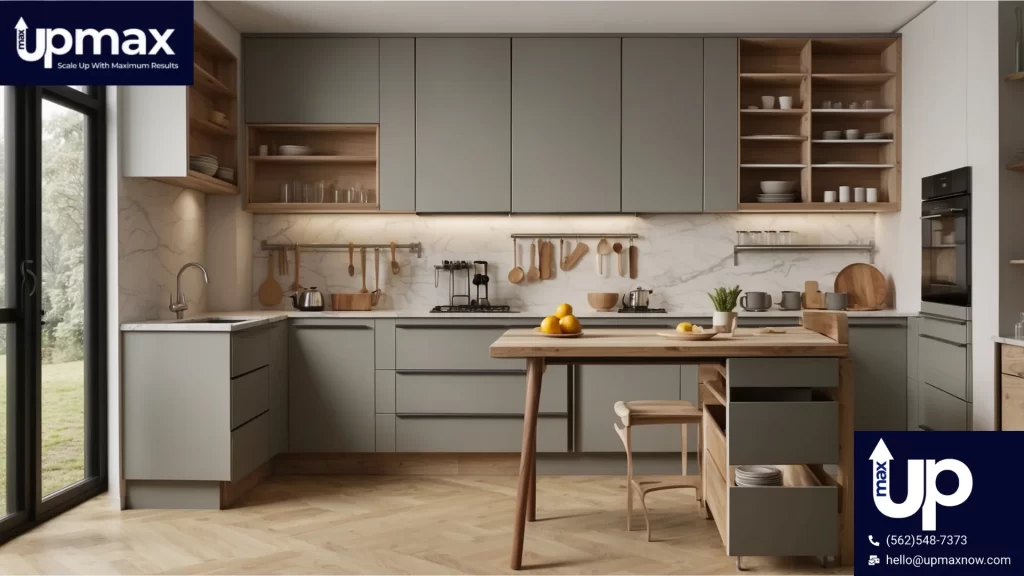
Integrating Aesthetics With Functionality
Integrating aesthetics with functionality in cabinet design involves a delicate balance between visual appeal and practical use. This approach encompasses materials that merge beauty and durability, such as combining sleek metal accents with sturdy wood construction. Color and texture are crucial in creating cabinets that complement the overall design scheme, from the refrigerator to the surrounding millwork. Designers must also consider incorporating personal style while maintaining efficiency, ensuring that cabinets store tableware effectively and contribute to the room‘s visual harmony. By carefully blending these elements, cabinet designers create visually stunning and highly functional spaces, enhancing the overall living experience.
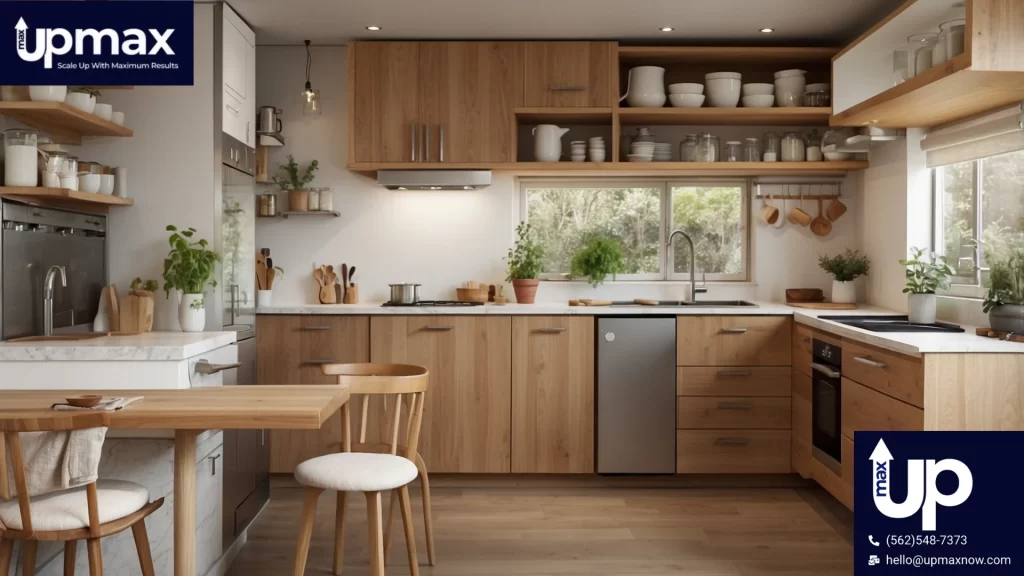
Balancing Visual Appeal and Practical Use
Architects masterfully balance visual appeal and practical use in cabinet design, crafting solutions that seamlessly integrate with farmhouse aesthetics while optimizing functionality. By incorporating adjustable shelves and strategic placement, designers create grey-toned cabinetry that complements rustic interiors while maximizing storage efficiency.
Customer service is crucial in achieving this balance, as designers work closely with clients to understand their unique needs and preferences. This collaborative approach ensures that every shelf and drawer serves a purpose while contributing to the overall visual harmony of the space:
| Design Element | Visual Appeal | Practical Use |
|---|---|---|
| Grey Finishes | Rustic Charm | Easy Maintenance |
| Open Shelving | Display Opportunities | Quick Access |
| Hidden Hardware | Sleek Appearance | Smooth Operation |
| Glass Inserts | Visual Interest | Item Visibility |
Selecting Materials That Merge Beauty and Durability
Cabinet designers expertly select materials that seamlessly blend beauty and durability, creating timeless pieces that withstand the test of time. Slate countertops paired with brass hardware offer a striking contrast, while marble accents elevate the overall aesthetic, providing a luxurious experience for homeowners.
The selection process extends beyond surface aesthetics, considering moisture resistance and wear patterns to ensure longevity. Designers carefully choose door materials that complement the chosen finishes, balancing visual appeal with practical considerations to create cabinets that maintain their allure throughout years of use.
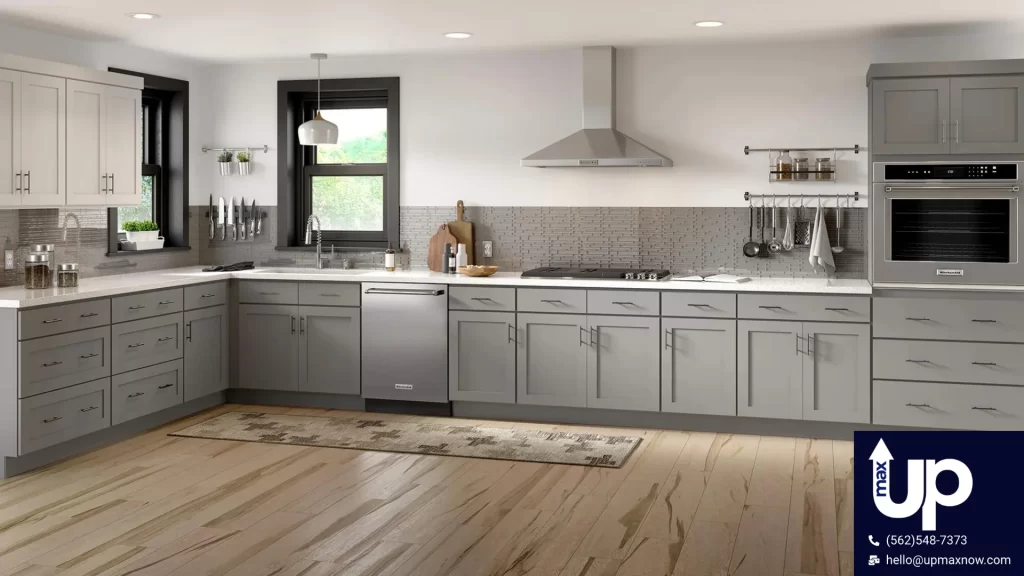
The Role of Color and Texture
Color and texture are pivotal in cabinet design, influencing the overall aesthetic appeal and functionality of spaces. Designers carefully select hues and finishes that complement the room‘s beauty while considering practical aspects like ease of cleaning and durability. The interplay between cabinet colors, granite countertops, and decorative molding creates a cohesive look that enhances customers’ cooking experience.
Texture adds depth and visual interest to cabinet surfaces, contributing to the tactile experience of users. Textures from smooth, lacquered finishes to rustic wood grains can evoke specific moods and complement various design styles. Thoughtful combinations of colors and textures in cabinet design elevate the overall ambiance of the space, creating a harmonious environment that balances form and function:
| Color/Texture | Visual Impact | Functional Benefit |
|---|---|---|
| Matte Black | Modern Sophistication | Fingerprint Resistance |
| Natural Wood Grain | Warmth and Character | Durability |
| High-Gloss White | Brightness and Space | Easy Cleaning |
| Textured Laminates | Depth and Interest | Scratch Resistance |
Incorporating Personal Style While Maintaining Efficiency
Homeowners can infuse personal style into their cabinet designs without sacrificing efficiency by selecting unique hardware, such as custom hinges or stainless steel pulls. These small touches allow for individuality while maintaining the functionality of the cabinets, ensuring smooth operation and longevity within any budget constraints.
Incorporating distinctive materials like walnut veneer or contrasting finishes can create a personalized look that still adheres to ergonomic principles. By carefully balancing these design elements with practical considerations, homeowners achieve cabinets that reflect their tastes while optimizing storage and accessibility.
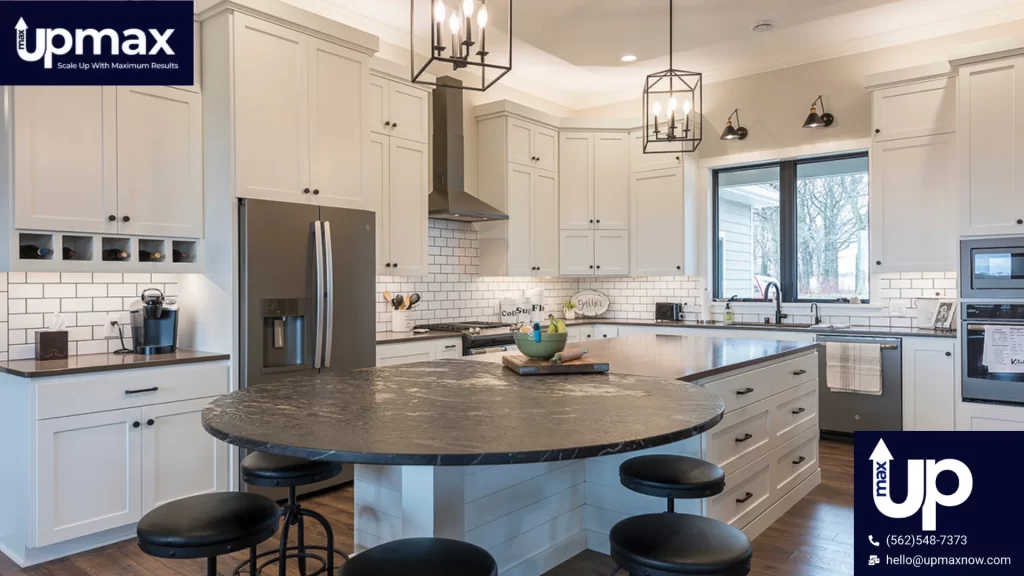
Maximizing Space Utilization in Cabinets
Maximizing space utilization in cabinets demands innovative approaches, transforming every inch into functional storage. Modern cabinet designs employ clever solutions to optimize small kitchens, harness vertical space, and make the most of awkward corners. From pull-out systems that enhance accessibility to hidden storage ideas that maintain a sleek aesthetic, these strategies revolutionize how homeowners organize their living spaces. By implementing these space-saving techniques, designers create cabinets that accommodate all necessary items and contribute to a clutter-free and visually appealing environment, regardless of the room‘s size or layout.
Innovative Storage Solutions for Small Kitchens
Innovative storage solutions transform small kitchens into highly functional spaces. Pull-out pantry systems maximize vertical storage, while corner cabinets with lazy Susans use previously wasted areas. These clever designs ensure that every inch of cabinet space serves a purpose, enhancing the kitchen‘s efficiency.
Multi-tiered drawer organizers and under-sink storage units optimize cabinet interiors, allowing for better organization of utensils, cleaning supplies, and cookware. Designers incorporate these solutions seamlessly into cabinet layouts, creating a clutter-free environment that enhances the overall aesthetic of compact kitchens:
- Vertical dividers for baking sheets and cutting boards
- Pull-down spice racks for upper cabinets
- Toe-kick drawers for rarely used items
- Magnetic knife strips inside cabinet doors
- Fold-out countertop extensions for additional workspace
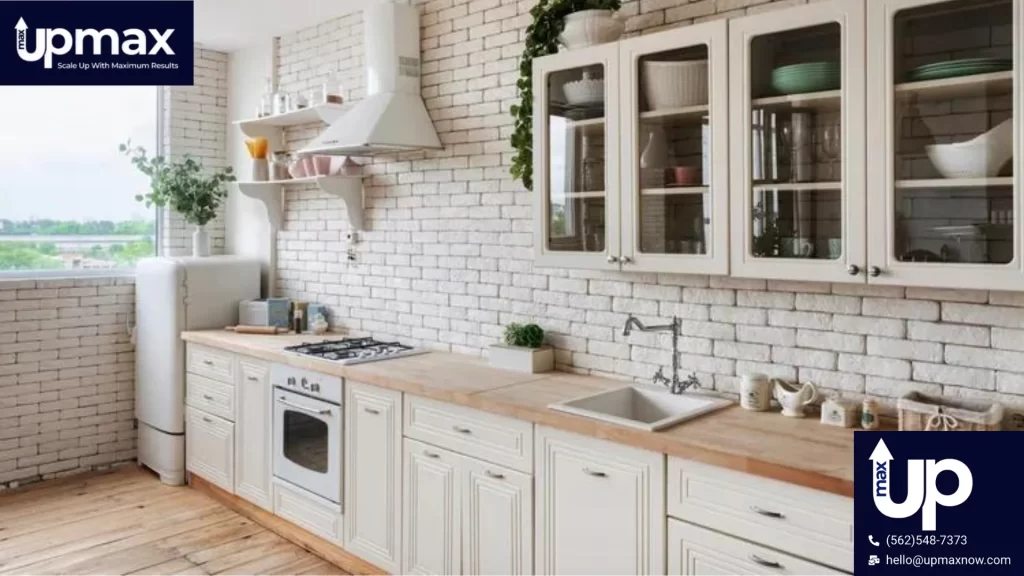
Utilizing Vertical Space Effectively
Vertical space optimization revolutionizes cabinet design, transforming unutilized areas into functional storage solutions. Designers incorporate tall, narrow cabinets that extend from floor to ceiling, maximizing storage capacity while maintaining a sleek aesthetic. These configurations often feature adjustable shelving systems, allowing homeowners to customize their storage based on changing needs.
Innovative pull-down mechanisms in upper cabinets bring hard-to-reach items within easy grasp, enhancing accessibility for users of all heights. Vertical drawer dividers organize items like baking sheets and cutting boards, while stackable storage containers efficiently use cabinet depth. By harnessing vertical space, designers create cabinets that accommodate more items without increasing the overall footprint of the kitchen or bathroom.
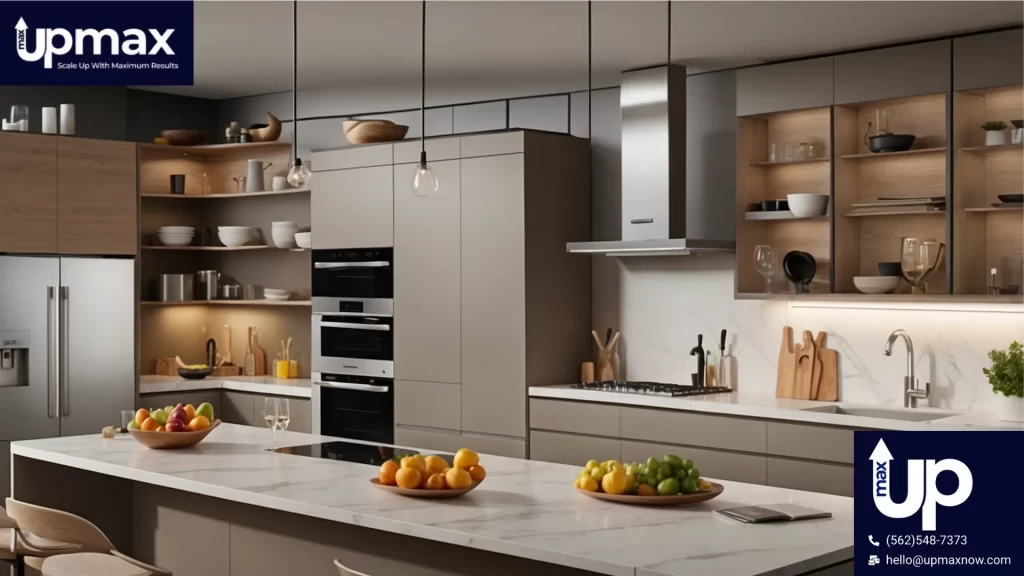
Corner Cabinets and Pull-Out Systems
Corner cabinets and pull-out systems revolutionize kitchen storage by transforming previously awkward spaces into highly functional areas. These innovative designs maximize the use of corner spaces, often considered dead zones in traditional cabinet layouts, by incorporating rotating shelves, diagonal drawers, or multi-tiered pull-out mechanisms.
Pull-out systems enhance accessibility and organization within cabinets, allowing users to reach items stored at the back easily. Designers integrate these features seamlessly into various cabinet types, from base units to tall pantries, providing homeowners with versatile storage solutions that adapt to their needs and kitchen configurations.
Hidden Storage Ideas
Hidden storage ideas transform cabinets into clever concealment spaces, maximizing functionality while maintaining a clean aesthetic. Designers incorporate secret compartments behind decorative panels, utilizing void spaces within walls to create unexpected storage nooks. These innovative solutions seamlessly blend into the overall design, preserving the room’s visual appeal while providing discreet places for valuables or rarely used items.
Toe-kick drawers and flip-up countertop sections offer additional hidden storage options, using often-overlooked spaces. Built-in charging stations disguised as drawer bottoms keep electronics out of sight while remaining easily accessible. These ingenious design elements not only enhance the cabinet’s storage capacity but also contribute to a clutter-free environment, elevating the overall functionality and aesthetics of the space.
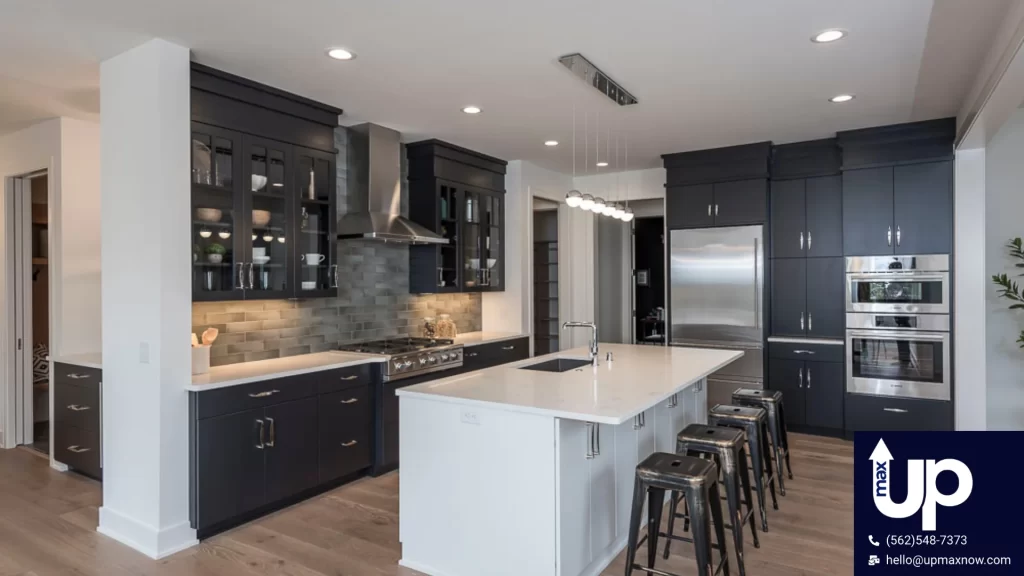
Sustainable Materials in Cabinet Designs
Sustainable materials in cabinet designs have become increasingly prevalent, offering eco-conscious solutions without compromising style or functionality. Modern cabinetry incorporates a range of environmentally friendly options, from responsibly sourced wood to recycled composites, that reduce environmental impact and enhance the aesthetic appeal of living spaces. These sustainable choices extend beyond the cabinet boxes, encompassing hardware, finishes, and innovative repurposing techniques. By prioritizing long-lasting designs and materials, cabinet makers contribute to waste reduction while creating products that stand the test of time, aligning with the growing demand for environmentally responsible home improvements.
Eco-Friendly Materials That Elevate Style
Eco-friendly materials elevate cabinet style while minimizing environmental impact. Reclaimed wood, bamboo, and cork offer unique textures and warm tones, adding character to kitchen and bathroom spaces. These sustainable options blend seamlessly with modern design trends, creating visually striking cabinets that appeal to environmentally conscious homeowners.
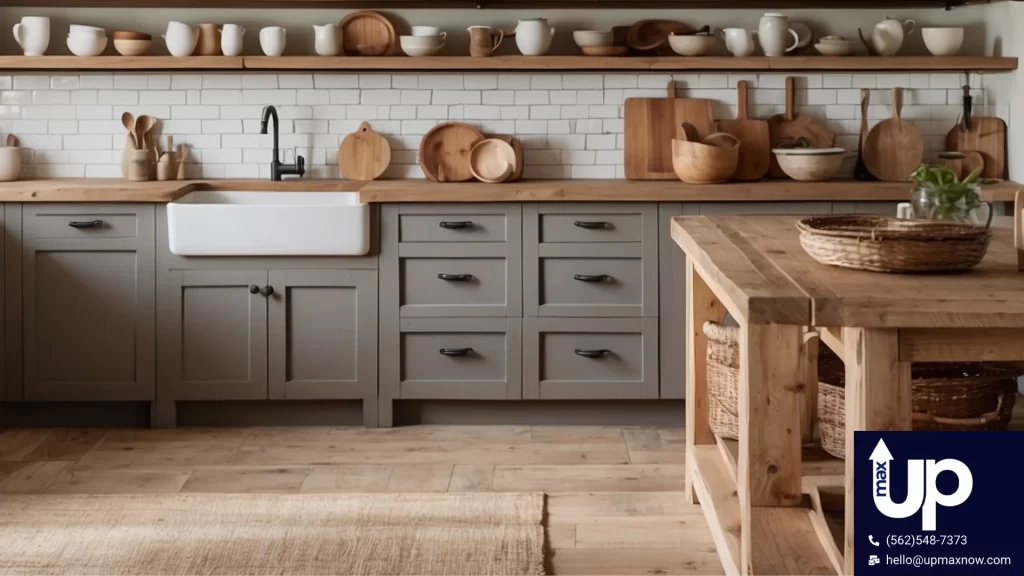
Innovative composites made from recycled plastics and agricultural waste provide durable, low-maintenance alternatives to traditional materials. These eco-friendly options often feature customizable colors and finishes, allowing designers to create sleek, contemporary cabinets that meet aesthetic and sustainability goals. By incorporating these materials, cabinet makers showcase their commitment to environmental stewardship without sacrificing style or quality.
The Benefits of Choosing Sustainable Hardware
Sustainable hardware enhances cabinet designs by reducing environmental impact while maintaining durability and aesthetics. Manufacturers create these eco-friendly options using recycled metals, bio-based materials, and low-VOC finishes, minimizing resource depletion and harmful emissions. These choices align with green building standards, contributing to healthier indoor environments and potentially increasing property value.
Choosing sustainable hardware usually leads to long-term cost savings due to increased longevity and reduced maintenance needs. Many eco-conscious manufacturers prioritize timeless designs, ensuring that sustainably sourced pulls, knobs, and hinges remain stylish for years to come. This approach supports a circular economy, reducing waste and promoting responsible consumption patterns in the cabinet industry.
Recycling and Repurposing in Cabinet Design
Cabinet designers embrace recycling and repurposing techniques to create unique, environmentally friendly pieces. They transform salvaged materials, such as old doors, wine crates, and industrial elements, into stunning cabinet components that tell a story. This approach reduces waste and infuses spaces with character and history.
Repurposing extends beyond visible elements, incorporating innovative solutions for cabinet interiors. Designers adapt unconventional items like tension rods, magnetic strips, and pegboards to enhance storage efficiency within existing cabinets. These creative solutions breathe new life into outdated pieces, aligning with sustainable design principles while meeting modern functional needs:
| Recycled/Repurposed Item | New Function | Environmental Benefit |
|---|---|---|
| Vintage Suitcases | Wall-Mounted Storage | Waste Reduction |
| Reclaimed Wood Pallets | Cabinet Doors | Resource Conservation |
| Antique Ladders | Vertical Storage Racks | Upcycling |
| Tin Ceiling Tiles | Decorative Cabinet Panels | Material Reuse |
Long-Lasting Designs to Reduce Waste
Cabinet designers prioritize long-lasting designs to reduce waste, incorporating durable materials and timeless aesthetics that withstand changing trends. They select high-quality hardware, robust joinery techniques, and moisture-resistant finishes to maintain cabinets’ functionality and appearance for decades. This approach minimizes the need for frequent replacements, significantly reducing the environmental impact associated with cabinet production and disposal.
Modular designs and adaptable components further enhance the longevity of cabinet systems, allowing for easy updates or reconfigurations as needs change. Designers focus on creating versatile storage solutions that accommodate evolving lifestyles, ensuring cabinets remain relevant and functional throughout their extended lifespan. These long-lasting designs contribute to a more sustainable approach to home furnishings by emphasizing durability and adaptability.
Technology Integration in Modern Cabinets
Technology integration in modern cabinets revolutionizes how homeowners interact with their storage spaces. From innovative storage solutions that optimize organization to touchless cabinets that enhance hygiene, these innovations transform everyday functionality. Lighting is pivotal in aesthetics and usability, illuminating cabinet interiors and creating ambiance. As the industry evolves, future trends point towards even more sophisticated cabinet technologies, promising enhanced convenience and customization. These advancements improve the user experience and contribute to contemporary living spaces’ overall efficiency and appeal.
Implementing Smart Storage Solutions
Modern cabinet designs incorporate smart storage solutions that leverage technology to maximize space utilization and enhance organization. These innovative systems include motorized shelves that adjust to accommodate items of varying heights, integrated inventory tracking systems that help manage pantry contents, and app-controlled drawer organizers that adapt to changing storage needs.
Smart storage solutions also extend to connectivity features, allowing cabinets to interface with other smart home devices. Voice-activated cabinet doors, climate-controlled compartments for perishables, and built-in charging stations for electronic devices exemplify how technology integration transforms traditional cabinet functionality into intelligent storage systems.
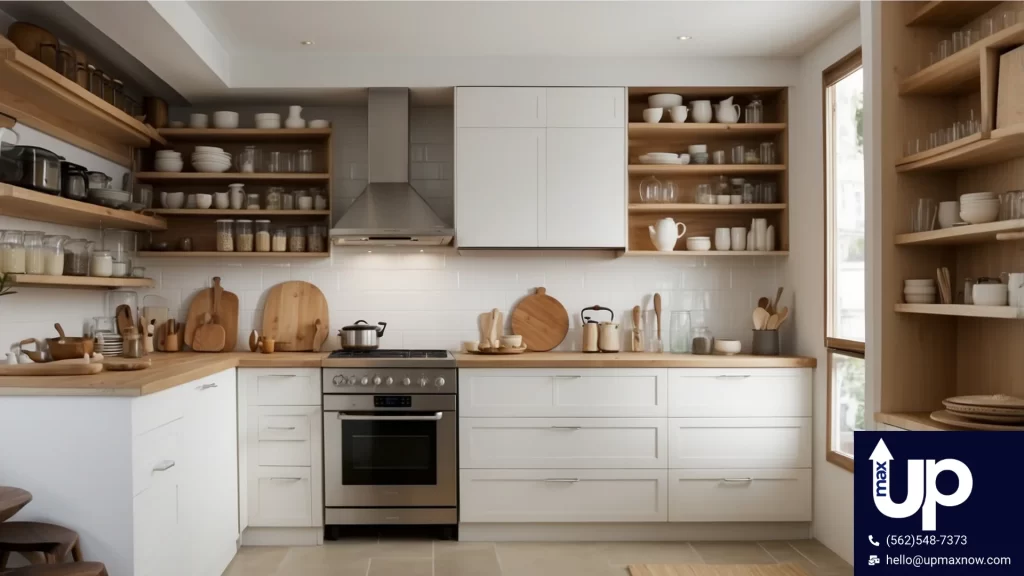
The Surge of Touchless Cabinets
Touchless cabinets have surged in popularity, driven by increased hygiene awareness and technological advancements. These innovative designs incorporate motion sensors or voice-activated mechanisms, allowing users to open drawers and doors without physical contact. This technology enhances cleanliness and improves accessibility for individuals with limited mobility.
Cabinet manufacturers have expanded their touchless offerings, integrating smart features such as automatic soft-close mechanisms and LED indicators. These advanced systems often connect to home automation platforms, enabling users to remotely monitor and control cabinet access. The surge in touchless cabinets reflects a broader trend toward creating more hygienic and technologically integrated living spaces:
| Touchless Feature | Benefit | Application |
|---|---|---|
| Motion Sensors | Hands-free Operation | Kitchen, Bathroom |
| Voice Activation | Accessibility | Pantry, Closets |
| Automatic Soft-Close | Noise Reduction | All Cabinet Types |
| Remote Access Control | Security | Home Offices, Storage Rooms |
Lighting: A Key Feature in Functionality and Aesthetics
Lighting integration transforms modern cabinets, enhancing both functionality and aesthetics. Strategic placement of LED strips, puck lights, and backlit panels illuminates interior spaces, improving visibility and creating a sophisticated ambiance. These lighting solutions often incorporate sensors and dimming capabilities, allowing users to customize the atmosphere while conserving energy.
Advanced cabinet lighting systems synchronize with smart home platforms, enabling automated schedules and remote control. Designers utilize lighting to highlight architectural features, accentuate display areas, and create visual depth within cabinet spaces. The thoughtful integration of lighting elevates the overall design and enhances the user experience, making cabinets more accessible and visually appealing.
Future Trends in Cabinet Technology
Future cabinet technology trends point towards increased integration of artificial intelligence and machine learning. These advancements will enable cabinets to learn user habits, automatically adjusting storage configurations and environmental conditions to optimize space utilization and preserve contents. Predictive maintenance systems will alert homeowners to potential issues before they become problematic, ensuring longevity and reducing repair costs.
Emerging technologies in materials science will revolutionize cabinet construction, introducing self-healing surfaces and nano-coatings that repel stains and bacteria. Augmented reality interfaces allow users to visualize cabinet contents without opening doors, streamlining organization, and meal planning. These innovations promise to transform cabinets from passive storage units into active contributors to home efficiency and wellness:
- AI-powered inventory management systems
- Biometric security features for sensitive storage areas
- Energy-harvesting cabinet surfaces to power integrated technologies.
- Modular, reconfigurable designs adaptable to changing needs
- Smart material integration for temperature and humidity control
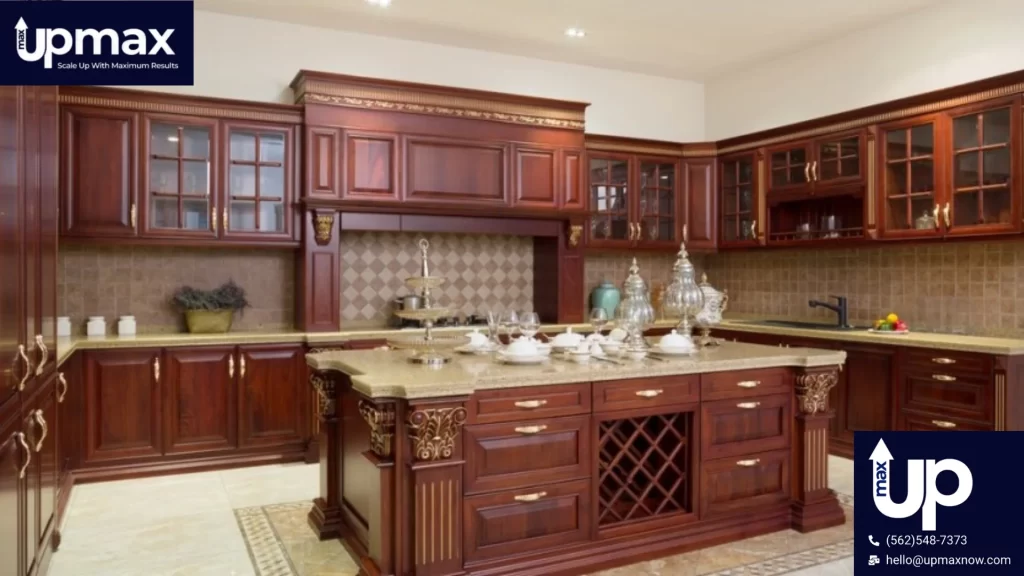
Custom Cabinet Design Considerations
Custom cabinet design offers unparalleled flexibility, allowing homeowners to create customized storage solutions to their unique needs and spaces. This approach goes beyond standard sizes and configurations, enabling the integration of personalized features that enhance functionality and aesthetics. When considering custom cabinetry, evaluating factors such as lifestyle requirements, space constraints, and long-term value is crucial. Collaboration with interior designers and architects ensures seamless integration with the overall design vision, while careful budgeting balances desire with financial realities. By exploring the nuances of custom versus pre-fabricated options, homeowners can make informed decisions that result in cabinets that meet their specific needs and add significant value to their living spaces.
When to Choose Custom Over Pre-Fabricated Cabinets
Custom cabinets become preferred when pre-fabricated options cannot meet unique space constraints or specific design requirements. Homeowners with non-standard room dimensions, irregular wall angles, or distinctive aesthetic preferences often find that custom cabinetry provides the flexibility needed to maximize space utilization and achieve their desired look.
Opting for custom cabinets allows for precise material selection, finish customization, and the incorporation of specialized storage solutions tailored to individual lifestyles. This level of personalization extends to hardware choices, integrated appliances, and ergonomic considerations that may not be available in pre-fabricated lines. Custom cabinetry particularly shines in the following scenarios:
- Historic home renovations requiring period-specific details
- Luxury kitchens demanding high-end materials and craftsmanship
- Multi-functional spaces needing adaptable storage solutions
- Homes with unusual architectural features or limited square footage
- Projects prioritizing sustainable or locally sourced materials
Tailoring Your Design to Your Specific Needs
Cabinet designers tailor solutions to meet specific needs by considering cooking habits, storage preferences, and lifestyle requirements. They analyze the homeowner’s daily routines, considering everything from the types of appliances used to the frequency of entertaining guests. This personalized approach ensures that every inch of cabinet space serves a purpose, enhancing efficiency and enjoyment in the kitchen or bathroom.
Custom cabinet designs accommodate unique items and special collections, incorporating features like wine racks, spice organizers, or display areas for cherished possessions. Designers work closely with clients to address mobility concerns, integrating pull-out shelves, lowered countertops, or other accessibility features as needed. This level of customization creates cabinets that fit the space ideally and align seamlessly with the homeowner’s way of life.
Coordinating With Interior Designers and Architects
Coordinating with interior designers and architects elevates custom cabinet projects to new heights of sophistication and integration. These professionals bring knowledge about spatial relationships, material compatibility, and design trends, ensuring that custom cabinets harmonize seamlessly with the overall aesthetic vision. Their expertise helps navigate complex design challenges, such as incorporating cabinets into open floor plans or creating cohesive transitions between living areas.
Collaboration between cabinet makers, interior designers, and architects fosters innovative solutions that merge form and function. This teamwork often results in multi-functional cabinet designs that serve as architectural elements, defining spaces while providing storage. The synergy of these disciplines leads to cohesive designs that enhance the flow and functionality of living spaces:
- Integrated lighting schemes that complement architectural features
- Custom finishes that align with the overall color palette and textures
- Cabinet configurations that frame views or create visual focal points
- Innovative storage solutions that address specific lifestyle needs
- Seamless integration of smart home technology within cabinetry
Budgeting for Custom Cabinetry
Budgeting for custom cabinetry requires careful consideration of materials, craftsmanship, and design complexity. Homeowners should allocate funds for high-quality hardware, specialized finishes, and unique storage solutions that elevate their cabinets beyond standard offerings. Factoring in the cost of professional installation and potential structural modifications ensures a comprehensive budget that accounts for all aspects of the project.
To maximize value, prioritize features that align with long-term needs and lifestyle preferences. Consider phasing the project or exploring cost-effective alternatives for less visible components while investing in key elements that significantly impact daily use and overall aesthetics. Collaborating with experienced designers can help identify areas where custom solutions provide the most significant return on investment.
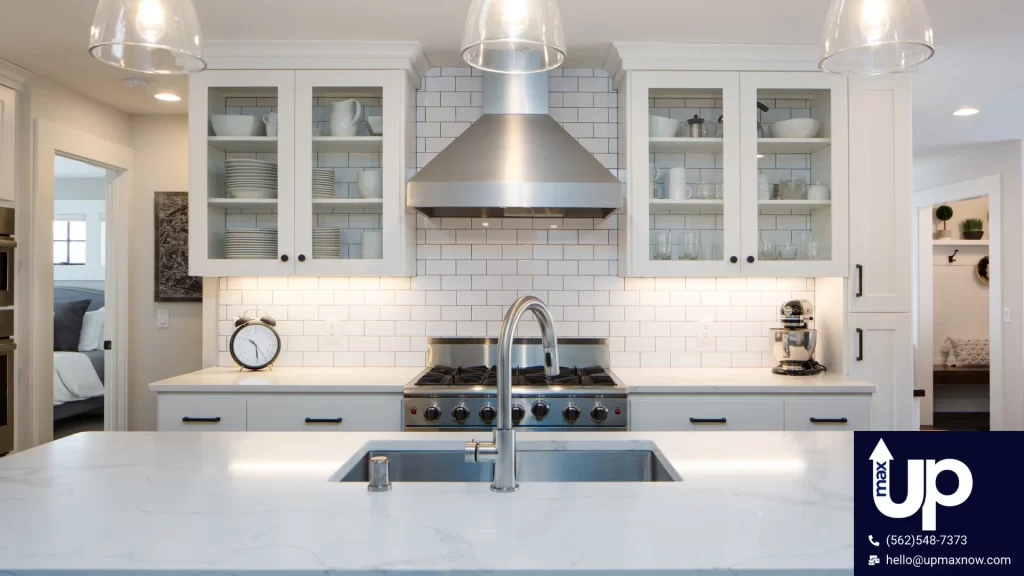
Latest Trends in Cabinet Designs
Cabinet design trends in 2023 reflect a dynamic blend of innovation and nostalgia, catering to diverse tastes and functional needs. From sleek, minimalist styles to ornate, vintage-inspired creations, modern cabinets showcase a wide array of aesthetics. Color palettes and finishes evolve, introducing bold hues and textured surfaces that redefine spatial atmospheres. Simultaneously, cabinet forms push boundaries, incorporating unconventional shapes and modular elements that challenge traditional norms. Amidst this novelty wave, a resurgence of classic designs offers timeless elegance, appealing to those who appreciate historical craftsmanship. These trends shape the visual landscape of living spaces and influence how homeowners interact with their storage solutions, marrying style with practicality in innovative ways.
Exploring 2023’s Popular Cabinet Styles
Cabinet styles in 2023 embrace a fusion of modern minimalism and rustic charm, catering to diverse aesthetic preferences. Sleek, handleless designs with push-to-open mechanisms dominate contemporary kitchens, while farmhouse-inspired shaker cabinets continue to appeal to those seeking a timeless look. Two-tone color schemes gain popularity, combining light upper cabinets with darker base units to create visual interest and depth.
Eco-conscious homeowners gravitate towards sustainable materials and natural finishes, driving demand for bamboo, reclaimed wood, and low-VOC painted cabinets. Mixed-material designs incorporating glass, metal, and wood elements offer unique textures and visual appeal. The trend towards open shelving persists, with floating shelves and glass-front cabinets providing opportunities to display curated collections and add personality to spaces:
| Cabinet Style | Key Features | Popular Applications |
|---|---|---|
| Handleless Modern | Smooth surfaces, integrated pulls | Contemporary kitchens, bathrooms |
| Farmhouse Shaker | Simple frame-and-panel design | Traditional and transitional spaces |
| Two-Tone | Contrasting color combinations | Kitchen islands, accent pieces |
| Eco-Friendly | Sustainable materials, natural finishes | Green homes, wellness-focused designs |
Emerging Color Schemes and Finishes
Cabinet color schemes and finishes in 2023 embrace bold choices and natural textures. Deep, moody hues like navy blue, forest green, and charcoal gray dominate modern kitchens, while warm earth tones and muted pastels offer a softer alternative. Matte finishes gain popularity, providing a sophisticated, low-glare surface that complements various design styles.
Textured finishes emerge as a prominent trend, with wood grain patterns, brushed metals, and tactile laminates adding depth to cabinet surfaces. Designers experiment with high-gloss accents and metallic details to create visual interest and contrast against matte backgrounds. These emerging color schemes and finishes reflect a growing desire for personalized, expressive spaces that balance aesthetics with practicality:
| Color/Finish | Characteristics | Popular Pairings |
|---|---|---|
| Navy Blue | Rich, versatile | Brass hardware, white countertops |
| Matte Black | Sleek, modern | Light wood accents, stainless steel |
| Brushed Gold | Warm, luxurious | Gray cabinets, marble surfaces |
| Textured Wood Grain | Natural, tactile | White walls, concrete counters |
Innovative Shapes and Forms in Modern Cabinets
Modern cabinet designs embrace innovative shapes and forms that challenge traditional rectangular configurations. Curved cabinets with sweeping lines create fluid, organic aesthetics in contemporary spaces, while asymmetrical arrangements offer dynamic visual interest. Designers experiment with geometric patterns, incorporating hexagonal and triangular shapes into cabinet fronts and overall structures.
Modular cabinet systems with interchangeable components allow for customizable configurations that adapt to changing needs. Floating cabinets with cantilevered designs create an illusion of weightlessness, enhancing the sense of space in compact rooms. These innovative forms serve as functional storage solutions and double as artistic focal points, blurring the line between furniture and architectural elements.
The Resurgence of Classic and Vintage Designs
Classic and vintage cabinet designs have experienced a resurgence in popularity, appealing to homeowners seeking timeless elegance and craftsmanship. Ornate moldings, raised panel doors, and intricate hardware reminiscent of bygone eras now grace modern kitchens and bathrooms. This revival celebrates the rich history of cabinetry while incorporating contemporary functionality and materials.
Designers reinterpret traditional styles such as Art Deco, Mid-Century Modern, and Victorian, adapting them to meet current needs and preferences. Vintage-inspired color palettes featuring rich wood tones and heritage paint colors add warmth and character to spaces. The resurgence of these classic designs offers a counterpoint to minimalist trends, allowing homeowners to create unique, personalized environments that stand the test of time:
| Vintage Style | Key Features | Modern Adaptation |
|---|---|---|
| Art Deco | Geometric patterns, luxe materials | Smart storage, LED lighting |
| Mid-Century Modern | Clean lines, natural wood | Sustainable materials, modular design |
| Victorian | Ornate details, dark finishes | Hidden tech integration, soft-close hardware |
| Craftsman | Exposed joinery, quarter-sawn oak | Eco-friendly finishes, ergonomic layouts |
Space-Saving Solutions for Tiny Homes and Apartments
Space-saving cabinet solutions revolutionize living in tiny homes and apartments, transforming compact spaces into highly functional environments. These innovative designs prioritize versatility and efficiency, offering multi-functional cabinets that adapt to daily needs. Foldable and retractable elements maximize usable space when needed, while clever integration of appliances into cabinetry streamlines kitchen layouts. Wall-mounted and hanging cabinets take advantage of vertical space, freeing up valuable floor area and creating an illusion of openness. By implementing these smart storage strategies, residents of small living spaces can enjoy the benefits of ample storage without sacrificing style or comfort.
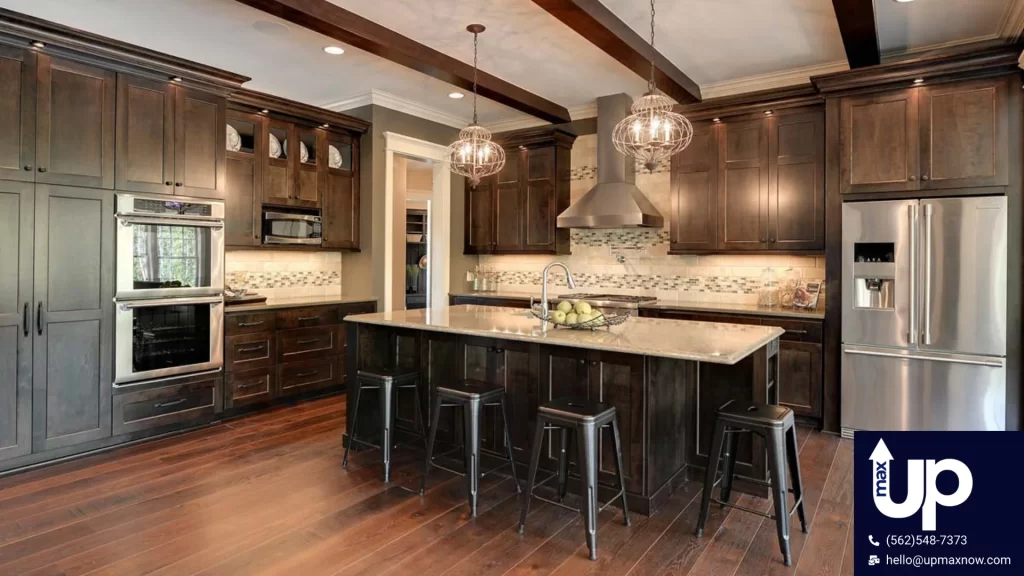
Multi-Functional Cabinets That Save Space
Multi-functional cabinets transform tiny homes and apartments by combining storage with essential living functions. These innovative designs incorporate fold-out desks, concealed dining tables, or built-in seating, maximizing space utilization without compromising comfort. Cabinet makers craft these versatile units to seamlessly transition between different uses, adapting to the ever-changing needs of compact living spaces.
Space-saving cabinets often integrate smart technology, enabling effortless transformations at the touch of a button. Motorized systems allow cabinets to reveal hidden appliances, workstations, or sleeping areas, creating dynamic living environments that evolve throughout the day. These multi-functional solutions optimize square footage and contribute to a clutter-free aesthetic, enhancing the overall spaciousness of small dwellings.
Foldable and Retractable Cabinet Designs
Foldable and retractable cabinet designs revolutionize space utilization in compact living areas. These innovative solutions allow homeowners to expand storage capacity when needed and tuck it away seamlessly when not in use. Designers incorporate mechanisms such as accordion-style doors, sliding panels, and pivot hinges to create cabinets that adapt to changing spatial requirements.
Retractable cabinet systems, such as Murphy beds or expandable kitchen islands, often integrate with furniture. This multi-functional approach maximizes floor space during the day while providing ample storage and functionality when required. The versatility of these designs enables residents to maintain a clutter-free environment without sacrificing storage capacity:
- Pull-out pantry systems that disappear into wall cavities
- Foldable work surfaces integrated into cabinet fronts.
- Rotating corner units that reveal hidden storage compartments
- Sliding cabinet doors that double as room dividers
- Retractable overhead cabinets activated by remote control
Integrating Appliances Into Cabinet Design
Integrating appliances into cabinet design revolutionizes space efficiency in compact homes. Designers seamlessly incorporate refrigerators, dishwashers, and ovens behind cabinet panels, creating a cohesive and uncluttered appearance. This approach not only maximizes storage potential but also enhances the overall aesthetic of small kitchens.
Cabinet makers employ innovative solutions to accommodate smaller appliances within drawers and pull-out units. Microwaves, coffee makers, and even washing machines find discreet homes within specially designed cabinet spaces, allowing residents to maintain a minimalist look while enjoying full functionality. These integrated designs often feature ventilation systems and easy-access panels, ensuring optimal performance and maintenance of hidden appliances.
Wall-Mounted and Hanging Cabinets for Extra Floor Space
Wall-mounted and hanging cabinets offer innovative solutions for maximizing floor space in tiny homes and apartments. These elevated storage options utilize vertical wall space, freeing up valuable square footage below for other furnishings or activities. Designers create floating cabinet systems that defy gravity, adding a sense of lightness and openness to compact living areas.
Suspended cabinets often incorporate adjustable shelving and modular components, allowing residents to customize their storage configurations as needs change. Some designs feature built-in lighting or glass fronts, doubling as display areas for cherished items while maintaining a spacious feel. By lifting storage off the floor, these cabinets create an illusion of larger rooms, enhancing the overall perception of space in small dwellings.
The Impact of Lighting on Cabinet Aesthetics and Functionality
Lighting transforms cabinet designs, elevating both aesthetics and functionality. Strategic illumination enhances visibility, creates ambiance, and showcases cabinet features. Under-cabinet lighting techniques revolutionize task areas, while natural light integration maximizes display potential. Smart lighting systems offer unprecedented control, adapting to user preferences and daily routines. The interplay between light and cabinetry improves usability and adds depth and dimension to living spaces, making lighting an indispensable element in modern cabinet design.
Choosing the Right Lighting for Visibility and Mood
Choosing the right lighting for cabinets involves balancing visibility and mood to enhance functionality and aesthetics. Task lighting, such as LED strips or puck lights, provides focused illumination for specific work areas, improving visibility and safety during food preparation or grooming activities. Ambient lighting, achieved through diffused cabinet-top fixtures or in-cabinet lighting, creates a welcoming atmosphere and adds depth to the space.
The color temperature of cabinet lighting significantly impacts mood and perception. Cooler temperatures (4000K-6500K) promote alertness and are ideal for task-oriented areas, while warmer temperatures (2700K-3000K) create a cozy, inviting ambiance suitable for dining or relaxation spaces. Designers often incorporate dimming capabilities and adjustable color temperatures to allow users to customize lighting based on the time of day or activity:
| Lighting Type | Purpose | Recommended Color Temperature |
|---|---|---|
| Task Lighting | Improve visibility for specific activities | 4000K-5000K (Cool White) |
| Ambient Lighting | Create overall atmosphere | 2700K-3000K (Warm White) |
| Accent Lighting | Highlight specific cabinet features | 3000K-4000K (Neutral White) |
| Display Lighting | Showcase decorative items | 3500K-4000K (Cool White) |
Under-Cabinet Lighting Techniques
Under-cabinet lighting techniques revolutionize kitchen functionality and ambiance. LED strip lights, puck lights, and tape lights offer versatile options for illuminating countertops and work areas. These low-profile fixtures provide targeted task lighting while minimizing shadows and glare, enhancing visibility for food preparation and other activities.
Advanced under-cabinet lighting systems incorporate motion sensors and dimming capabilities, allowing for hands-free operation and customizable brightness levels. Some designs feature color-changing LEDs, enabling users to adjust the lighting atmosphere to suit different moods or occasions. Proper installation techniques, such as using diffusers and positioning lights toward the front of cabinets, maximize light distribution and minimize harsh reflections:
- Slim-profile LED strips for seamless integration
- Wireless puck lights for easy installation and battery-operated convenience
- Color-temperature adjustable systems for versatile lighting options
- Smart-home compatible fixtures for voice-activated control
- Energy-efficient options with automatic shut-off features
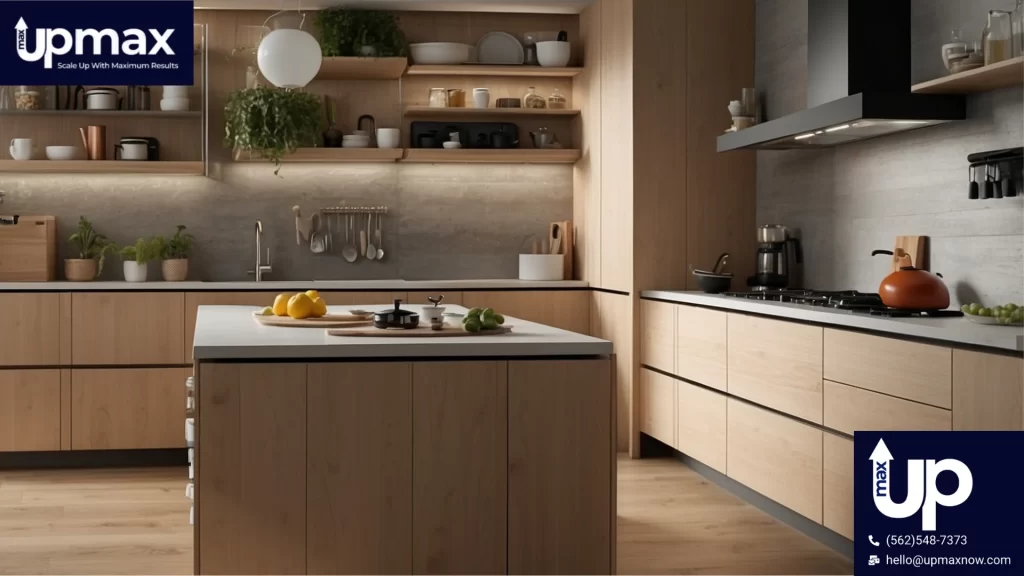
The Role of Natural Light in Cabinet Display
Natural light plays a pivotal role in cabinet display, enhancing the visual appeal of materials and finishes. Strategic placement of cabinets near windows or skylights allows sunlight to highlight textures, colors, and unique design features. This interplay between natural light and cabinetry creates dynamic shadows and reflections that evolve throughout the day, adding depth and interest to the space.
Designers incorporate translucent or glass cabinet doors to maximize the benefits of natural light, allowing it to penetrate deeper into storage areas. This approach improves visibility and creates an illusion of expanded space. Careful consideration of cabinet orientation and material selection ensures that natural light enhances rather than damages stored items:
- Position display cabinets perpendicular to windows to minimize glare
- Use UV-resistant finishes to protect cabinet contents from sun damage.
- Incorporate light-filtering materials in cabinet doors to diffuse harsh sunlight.
- Design open shelving near light sources to create airy, well-lit displays.
- Integrate mirrors or reflective surfaces to amplify natural light in darker areas.
Smart Lighting Systems for Enhanced Functionality
Smart lighting systems revolutionize cabinet functionality by offering unprecedented control and customization. These advanced systems integrate with home automation platforms, allowing users to adjust cabinet lighting through voice commands, smartphone apps, or motion sensors. Programmable settings enable the creation of personalized lighting scenes that adapt to different times of day or specific activities, enhancing both the usability and ambiance of cabinet spaces.
Cabinet designers incorporate smart lighting technologies to address specific functional needs. Proximity sensors trigger internal cabinet lights when doors are opened, improving visibility and energy efficiency. Color-changing LEDs in display cabinets allow homeowners to highlight collections or create mood lighting for special occasions. These intelligent systems often include energy monitoring features, helping users optimize their lighting usage and reduce electricity consumption.
Selecting Durable Materials for Long-Lasting Cabinets
Selecting durable materials for long-lasting cabinets requires careful consideration of various factors, including environmental conditions, usage patterns, and aesthetic preferences. The choice between wood, metal, and composite materials impacts not only the longevity of cabinets but also their appearance and maintenance requirements. Different finish options offer unique advantages and drawbacks, influencing both cabinet surfaces’ visual appeal and resilience.
Understanding proper maintenance techniques for various materials ensures cabinets retain their beauty and functionality over time. Additionally, factoring in local weather and humidity conditions is crucial in material selection, particularly for cabinets exposed to fluctuating environmental factors. By evaluating these aspects, homeowners and designers can make informed decisions that result in cabinets that withstand the test of time while maintaining their aesthetic appeal.
Comparing Wood, Metal, and Composite Materials
Wood, metal, and composite materials offer distinct advantages for cabinet construction, each catering to different aesthetic preferences and functional requirements. Wood cabinets provide a timeless appeal and natural warmth, with hardwoods like oak, maple, and cherry offering superior durability. Metal cabinets, typically made from stainless steel or aluminum, are durable and resistant to moisture, making them ideal for industrial or modern designs.
Composite materials, such as medium-density fiberboard (MDF) and plywood, combine affordability with stability, resisting warping and shrinkage better than solid wood. These engineered materials often serve as substrates for veneers or laminates, allowing for various finishes and styles. When selecting cabinet materials, consider factors such as:
- Environmental conditions (humidity, temperature fluctuations)
- Expected wear and tear
- Desired aesthetic and finish options
- Budget constraints and long-term value
- Eco-friendliness and sustainability concerns
The Pros and Cons of Different Finish Options
Cabinet finish options range from natural wood stains to high-gloss lacquers, each presenting unique advantages and challenges. Natural wood finishes showcase the material’s inherent beauty and grain patterns, offering a warm, classic look that ages gracefully. However, these finishes may require more frequent maintenance and can be susceptible to scratches and UV damage.
Painted finishes provide endless color possibilities and can conceal imperfections in the wood but may chip or peel over time, especially in high-moisture environments. High-gloss lacquers create a sleek, modern appearance and offer excellent durability, though they can highlight surface imperfections and may be more challenging to repair if damaged.
Maintenance Tips for Various Cabinet Surfaces
Regular maintenance ensures the longevity and beauty of cabinet surfaces across various materials. Wood cabinets benefit from periodic polishing with specialized wood cleaners and oils to protect against moisture and maintain their natural luster. Metal surfaces require gentle cleaning with non-abrasive solutions to prevent scratching and keep their shine.
Composite materials and laminates often need a damp cloth for routine cleaning, but stubborn stains may require mild detergents. For all cabinet types, promptly addressing spills and avoiding harsh chemicals or abrasive tools help preserve the finish and extend the life of the cabinets. Consider the following maintenance schedule for different cabinet materials:
| Cabinet Material | Cleaning Frequency | Recommended Maintenance |
|---|---|---|
| Solid Wood | Weekly | Dust, polish quarterly |
| Metal | Bi-weekly | Wipe clean, buff monthly |
| Laminate | As needed | Damp cloth, avoid excess moisture |
| Painted | Monthly | Gentle cleaner, touch up chips |
Weather and Humidity Considerations in Material Selection
Weather and humidity significantly impact cabinet material selection, particularly in regions with extreme temperature fluctuations or high moisture levels. Wood expands and contracts with changes in humidity, potentially leading to warping or cracking if not adequately accounted for in the design and construction process. Engineered wood products like medium-density fiberboard (MDF) offer improved stability in fluctuating conditions but may require additional protective finishes in high-humidity environments.
While moisture-resistant, metal cabinets can be prone to condensation in humid climates, necessitating proper ventilation and insulation. Composite materials and high-pressure laminates often resist environmental factors, making them suitable choices for areas with challenging weather conditions. When selecting cabinet materials for specific climates, consider the following factors:
- Local humidity levels and seasonal variations
- Exposure to direct sunlight or temperature extremes
- Proximity to moisture sources (e.g., sinks, dishwashers)
- Indoor climate control systems and their effectiveness
- Long-term maintenance requirements for different materials
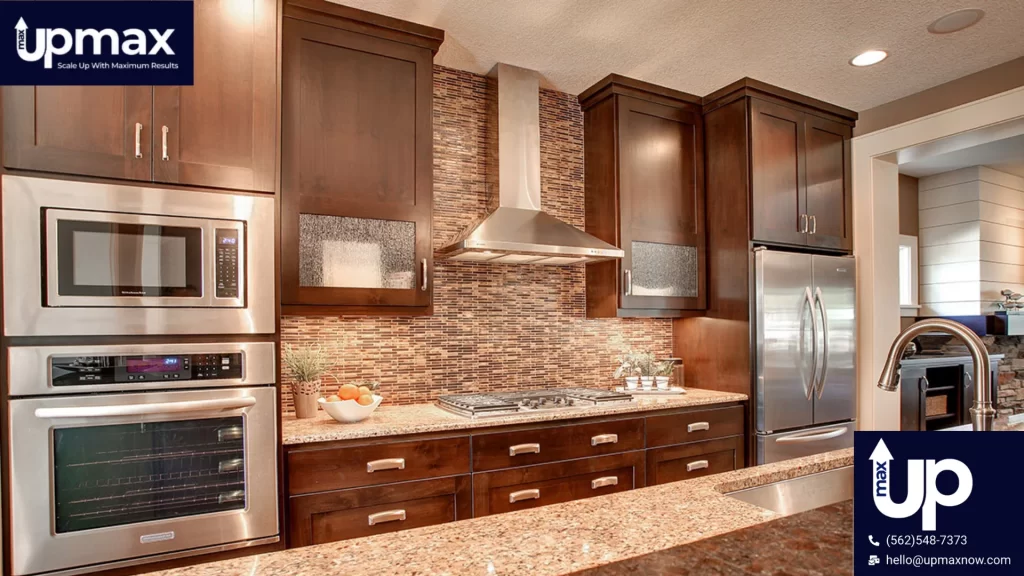
FAQs for Cabinet Designs: Key Principles in Ergonomics, Aesthetics, Functionality, and Space Utilization
Should I use MDF or plywood for cabinets?
Plywood is generally better for cabinet construction than MDF (Medium Density Fiberboard). Plywood is more durable, holds screws better, and is less prone to sagging or swelling when exposed to moisture. MDF can be a suitable substrate for laminated countertops, but plywood is preferred for the actual cabinet boxes for its strength and stability.
What is the most sustainable wood for kitchen cabinets?
When choosing sustainable materials for kitchen cabinets, look for locally sourced hardwoods like maple, oak, or birch. If reclaimed wood is available in your area, it is also a great eco-friendly option. Bamboo is another sustainable choice, but make bamboo planks with low-VOC adhesives for the best environmental impact.
What are the three types of materials used in constructing cabinets?
The three primary materials used for cabinet construction are:
- Plywood – A durable, stable material that holds screws well and resists sagging
- MDF – Can provide a smooth surface for painting but is heavier and less moisture-resistant than plywood
- Solid wood – Used for face frames, doors, and drawers. Maple, oak, and birch are common choices.
What is the best material to use for kitchen cabinets?
Plywood is the best overall material for cabinet boxes. It provides strength, stability, and moisture resistance. Solid hardwoods like maple, oak, or birch are ideal for the face frames, doors, and drawers. If painting, poplar is a good economical choice for the face frames.
What are the pros and cons of MDF cabinets?
Pros of MDF cabinets:
- Provides a smooth surface for painting
- Can be more cost effective than plywood
Cons of MDF cabinets:
- Less durable and more prone to sagging than plywood
- Swells and chips when exposed to moisture
- Holds screws less securely than plywood
What material is best for kitchen cabinet hardware?
The material for cabinet hardware is less critical than the material for the cabinet’s construction. Durable metal hardware, like brushed nickel or oil-rubbed bronze, is a popular choice for its aesthetic appeal and durability. Soft-close hinges and drawer slides provide a high-end feel and prevent slamming.
What is the rule of thumb for cabinet hardware?
A good rule of thumb for cabinet hardware placement is:
- Drawers: 1/3 to 1/2 the drawer height from the bottom
- Doors: Place handles 2-3 inches from the edge, centered vertically
- Pulls: Place 1/3 to 1/2 the drawer width from each end
- Hinges: Typically 3-4 per door, spaced evenly
This placement provides an ergonomic and visually balanced look for the cabinet hardware.
What cabinet hardware is timeless?
Timeless cabinet hardware includes simple and classic designs like brushed nickel, oil-rubbed bronze, and matte black. These finishes offer durability and a versatile aesthetic that complements various kitchen cabinet designs, from traditional to contemporary. For a timeless look, opt for minimalist and ergonomic cabinets that focus on user comfort and functionality.
What is the trend in kitchen cabinet hardware?
Current trends in kitchen cabinet hardware include mixed metals, sleek minimalist designs, and cutting-edge materials like matte finishes and sustainable materials. Innovative cabinet designs often feature bold colors and geometric shapes, adding a touch of modern aesthetics to kitchen cabinets. Smart cabinet designs with integrated technology, such as touch-to-open mechanisms and LED lighting, are becoming increasingly popular.
What is the most popular cabinet type?
The most popular cabinet type remains the Shaker-style cabinet due to its clean lines, functional design, and versatile aesthetic appeal. Shaker cabinets often comprise sustainable cabinet designs made from high-quality, eco-friendly materials. They can be adapted to suit various interior styles, making them a favorite in traditional and modern kitchen designs.
Is it cheaper to build a cabinet or buy one?
Building a cabinet can be cheaper if you have the necessary skills, tools, and time. However, buying pre-made cabinets is more cost-effective and time-efficient for most people. Custom cabinet designs offer personalized cabinet designs that fit specific space utilization needs and aesthetics but come at a higher price. Pre-made cabinets often balance functionality, durability, and cost, featuring ergonomic and modern cabinet designs suitable for various budgets.
What is modern kitchen cabinet design?
Modern kitchen cabinet design focuses on clean lines, minimalist aesthetics, and innovative storage solutions. It emphasizes using durable, sustainable materials and incorporates cutting-edge technology for enhanced functionality. Contemporary cabinet designs often feature sleek finishes, handleless doors, and smart cabinet designs that improve user comfort and space utilization. Additionally, modern kitchen design prioritizes ergonomic cabinet designs to ensure ease of use and accessibility.
How to design a kitchen unit?
Designing a kitchen unit involves considering the layout, functionality, aesthetics, and space utilization. Start by assessing your kitchen space and identifying the work triangle (the relationship between the sink, stove, and refrigerator). Choose cabinetry that complements your kitchen design, focusing on ergonomic cabinet designs and innovative storage solutions.
Opt for high-quality materials and finishes that match your style, whether you prefer modern cabinet designs or traditional aesthetics. Incorporate smart cabinet designs and sustainable materials to enhance functionality and environmental friendliness.
How do I design my kitchen layout?
Designing a kitchen layout involves planning for efficiency, ergonomics, and aesthetics. Start by mapping the work triangle to ensure easy access between the sink, stove, and refrigerator. Consider incorporating functional cabinet designs that offer ample storage and innovative solutions for space utilization.
Choose a layout that suits your lifestyle, whether an open-plan or galley kitchen. Prioritize user comfort with ergonomic cabinet designs and modern kitchen design principles. Select materials and finishes that reflect your aesthetic preferences, ensuring a cohesive and stylish kitchen.
How to design a kitchen basics?
To design a kitchen:
- Begin with a clear understanding of the basic principles: ergonomics, functionality, and aesthetics.
- Start by assessing your space and planning the layout around the work triangle.
- Choose kitchen cabinets that provide innovative storage solutions and maximize space utilization.
- Focus on durable, sustainable materials and high-quality finishes.
Incorporate ergonomic cabinet designs to enhance user comfort and accessibility. Finally, ensure your design reflects your style, blending contemporary cabinet designs with practical and stylish elements that create a cohesive and functional kitchen.

Hear from Our Delighted Clients
Fatih T. – Owner of Vega Kitchen and Bath
Fatih T. and his team at Vega Kitchen and Bath have been working with UPMAX for over a year and are thrilled with their decision. The platform has greatly simplified communication among vendors, clients, and other stakeholders, making it an indispensable tool for their business.
UPMAX has also helped Vega Kitchen and Bath streamline their process timelines, ensuring projects are completed efficiently and on track. Fatih highly recommends giving UPMAX a try, confident that others will find it just as beneficial as his team has.
Isa P. – Owner of Kitchen Design Center
Isa P. started working with UPMAX just a couple of months ago and has already seen significant improvements in their advertising, social media, and overall marketing efforts. The UPMAX team provides invaluable advice and support and is always ready to assist with any online or social media-related issues that arise.
Kitchen Design Center appreciates the prompt and helpful responses they receive from UPMAX whenever they have questions or concerns. The level of support and expertise provided by the UPMAX team has been instrumental in helping Isa and her business navigate the digital marketing landscape with confidence.
Ali D. – Co-Owner of Cabinet Era
Ali D., the co-owner of Cabinet Era, has been collaborating with UPMAX for an extended period and couldn’t be happier with the exceptional service they receive. The quality of leads generated through the partnership has been outstanding, leading to remarkable success for Cabinet Era.
The Cabinet Era team is excited to continue its successful partnership with UPMAX and highly recommends joining forces with the UPMAX team without hesitation. They are confident that other businesses will benefit from the same lead quality and success they have experienced.
Discover the potential for your business by partnering with UPMAX, just like Fatih, Isa, Ali and their team have done. Our proven strategies and dedicated team will work tirelessly to generate high-quality leads and help your business achieve new levels of success.
Conclusion
Cabinet designs have evolved significantly, incorporating ergonomic principles, aesthetic considerations, functional innovations, and space-saving solutions. These advancements have transformed cabinets from mere storage units into integral components of modern living spaces, enhancing form and function.
Ergonomics in cabinet design ensures that storage solutions are accessible and comfortable for users of all abilities. Designers now prioritize reach distances, optimal heights, and user-friendly mechanisms to create cabinets that seamlessly integrate into daily routines. This focus on human-centered design has revolutionized how people interact with their living spaces.
The marriage of aesthetics and functionality in cabinet design has led to various styles, materials, and finishes. From sleek, minimalist designs to ornate, traditional creations, cabinets now serve as statement pieces that reflect personal taste while meeting practical needs. Integrating technology and sustainable materials further enhances the appeal and longevity of modern cabinet designs.
Space utilization has become paramount in cabinet design, particularly for tiny homes and apartments. Innovative solutions such as multi-functional cabinets, foldable designs, and clever appliance integration have maximized storage capacity without compromising on style. These advancements enable homeowners to make the most of their living spaces, regardless of size constraints.


